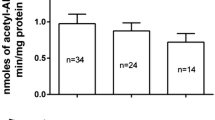Summary
N-acetylation polymorphism is one of the representative pharmacogenetic traits that underlie interindividual and interethnic differences in response to xenobiotics. To develop a practical genotyping method to predict acetylator phenotype, we studied the conditions for accurate phenotyping, and identified the phenotype in 51 Japanese. Then we performed Southern blot analysis of genomic DNA from these subjects using 32P-labeled cDNA for polymorphic N-acetyltransferase in the liver, and found that four N-acetyltransferase alleles generated six genotypes. The present genotyping method predicted the rapid, intermediate, and slow acetylators correctly in 48 of 51 overall subjects (96%) and in all of 4 slow acetylators.
Similar content being viewed by others
References
Blum M, Grant DM, McBride W, Heim M, Meyer UA (1990) Human arylamine N-acetyltransferase genes: isolation, chromosomal localization, and functional expression. DNA Cell Biol 9:193–203
Blum M, Demierre A, Grant DM, Heim M, Meyer UA (1991) Molecular mechanism of slow acetylation of drugs and carcinogens in humans. Proc Natl Acad Sci USA 88:5237–5241
Deguchi T, Mashimo M, Suzuki T (1990) Correlation between acetylator phenotypes and genotypes of polymorphic arylamine N-acetyltransferase in human liver. J Biol Chem 265:12757–12760
Ebisawa T, Deguchi T (1991) Structure and restriction fragment length polymorphism of genes for human liver arylamine N-acetyltransferases. Biochem Biophys Res Commun 177:1252–1257
Evans DAP (1989) N-acetyltransferase. Pharmacol Ther 42:157–234
Fox HH, Gibas JT (1953) Synthetic tuberculostats. VIII. Acyl derivatives of isonicotinyl hydrazine. J Org Chem 18:1375–1379
Herrmann BG, Frischauf A-M (1987) Isolation of genomic DNA. Methods Enzymol 152:180–183
Hutchings A, Monie RD, Spragg B, Routledge PA (1983a) Highperformance liquid chromatographic analysis on isoniazid and acetylisoniazid in biological fluids. J Chromatogr 277:385–390
Hutchings A, Monie RD, Spragg B, Routledge PA (1983b) A method to prevent the loss of isoniazid and acetylisoniazid in human plasma. Br J Clin Pharmacol 15:263–266
Moulin MA, Albessard F, Lacotte J, Camsonne R (1981) Hydrophilic ion-pair reversed-phase high-performance liquid chromatography for the simultaneous assay of isoniazid and acetylisoniazid in serum: a microscale procedure. J Chromatogr 226:250–254
Ohsako S, Deguchi T (1990) Cloning and expression of cDNAs for polymorphic and monomorphic arylamine N-acetyltransferases from human liver. J Biol Chem 265:4630–4634
Sim E, Hickman D (1991) Polymorphism in human N-acetyltransferase: the case of the missing allele. Trends Pharmacol Sci 12:211–213
Sunahara S, Urano M, Ogawa M (1961) Genetical and geographic studies on isoniazid inactivation. Science 134:1530–1531
Vatsis KP, Martell KJ, Weber WW (1991) Diverse point mutations in the human gene for polymorphic N-acetyltransferase. Proc Natl Acad Sci USA 88:6333–6337
Weber WW, Hein DW (1985) N-acetylation pharmacogenetics. Pharmacol Rev 37:25–79
Author information
Authors and Affiliations
Rights and permissions
About this article
Cite this article
Mashimo, M., Suzuki, T., Abe, M. et al. Molecular genotyping of N-acetylation polymorphism to predict phenotype. Hum Genet 90, 139–143 (1992). https://doi.org/10.1007/BF00210758
Received:
Revised:
Issue Date:
DOI: https://doi.org/10.1007/BF00210758




